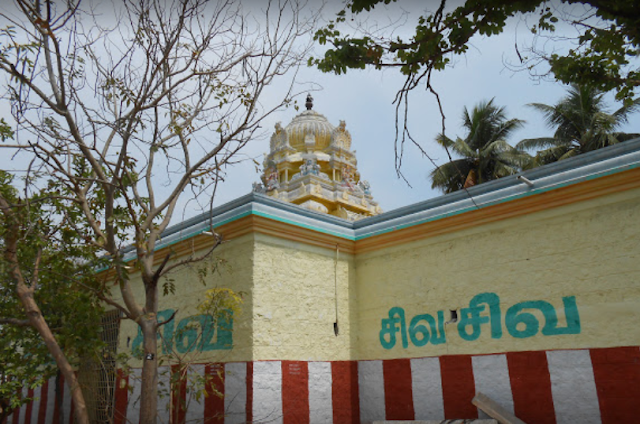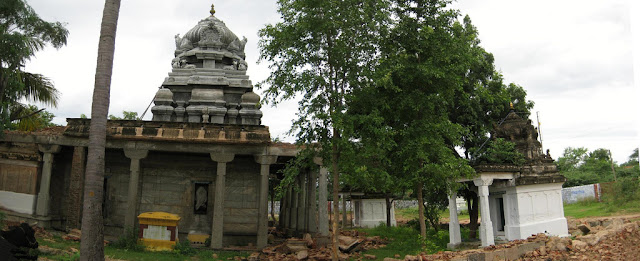Deivanayaka Easwarar Temple (Arambeshwarar Temple),
Ilambaiyangkottur – The Temple
This
temple is considered to be significant for its three important attributes –
Murthy, Sthalam and Theertham - glory of Lord, sacredness of the land and the
auspicious temple tank. This is an east facing temple and it has two
corridors. Instead of a main tower (Rajagopuram), there is an arch type
entrance from west. The Dwajasthambam is standing separately
without kavasam. Nandhi and Palipeedam are at the ground level under a small
mandapam. Bali peetha, flag post and Nandi idol are found facing the main
shrine.
Presiding
Deity is called as Arambeshwarar / Chandrasekharar / Deivanayakeswarar. Mother
is called as Kanaka Kujambikai / Kodenthu Mulaiyammai. The Swayambu lingam here
is mixture of white and red colours and is covered most of the times by a metal
sheet (Kavacham). It is said that every year from April 2 to 7 and from
September 5 to 11, sun rays fall directly on the lingam in this temple. During
that time, it is believed that the Sun God (Suryan) is worshiping Lord Shiva.
This lingam is not touched by human hands, not even by the priests, as it is
“Theendathirumeni”.
Lord
Shiva appears so soft here as the petals of Kondrai flower. Cow Puja (Gopuja)
is performed daily in the temple. Clothes and flowers are being offered with
the help of a stick. Nirudha Ganapati, Dakshina Murti, Vishnu, Durga, Brahma
and Chandikeswarar are found as the koshta deities on the wall around the main
shrine. Dakshina Murti is very popular; he is found in a different posture with
'chin mudra'. He is called as 'Yoga Dakshina Murti'; the site is also
considered as one of Guru Sthalams.
Mother Kanakakujambigai is
facing south on the Sri Chakra Peeta and she is slightly bigger idol found in a
separate sub-shrine in the prakaram. Rice is offered as Nivedhana. There are
two Ambal Sannadhi one is in the inner prakaram and other is outer prakaram. The
Arambeshwarar with his sixteen sides is found to the South East of the temple,
waiting to grant the sixteen boons of prosperity to his devotees.
Another
speciality of the temple is the Yoga Dakshinamurthy found at the Goshtam. With
his eyes closed and right hands forming the Chin Mudra, and placed on the
Brahma knot of the Yagnopaveetham, holding a Trishul and Akka Maalai in the top
hands, he is found in a very unique posture. On special days, like Guru
Peyarchi, several hundreds of devotees come here to pray to Yoga
Dakshinamurthy.
There
are two prakaras in this temple. The outer prakara has two sub-shrines -
Ganesha and Subramanya with his consorts. The inner prakara too has two sub - shrines
- Ganesha and Subramanya. Shrines and idols of Lords Vinayakar, Hanuman, Mahavishnu,
Suryan, Chandran, Brahma, Bairavar, Durgai and Chandikeswarar can be seen in
the corridor. Theertham associated with this temple are Chandra Theertham and Malligai
Theertham. The sacred tank south of the temple is referred to as Chandra
Theertham. Sthala Vriksham is Mara
Malligai.
There is
a Vedha Paata Shala inside the temple but didn’t seem like it was being
used. In the year 1983, there is said to have been heavy rains where
lightning struck on the village. The Lord took it upon himself and other than
his vimana, nothing else was damaged in the village. The villagers say, but for
the grace of the Lord, major damage would have been caused by the magnitude of
the lightning. The temple which was built by the Cholas and later renovated by
the Pandyas lost its heritage value completely; the current structure is an
entirely renovated one during the modern days.
An
inscription belonging to the time of Chola king Rajadhiraja II - 1175 AD
mentions that this temple was converted from a brick temple to a stone temple
by Pandari Sivacharanaalayan alias Sivapadhasekara Muvendavelan. An inscription
from the time of Kulothunga III refers to Ilambaiyangkottur as Cholavichchadira
Chadurvedi Mangalam in Kanrur Nadu. An inscription of Vijayagandagopaladeva
states that he gave the village of Kaliyanallur in Tiruvelurnadu, as gift to
the temple. There are also inscriptions of the Pandya king Konerinmaikondan
about grants given to the temple. These inscriptions have been recorded but
unfortunately are not found in the modernized temple today.



































